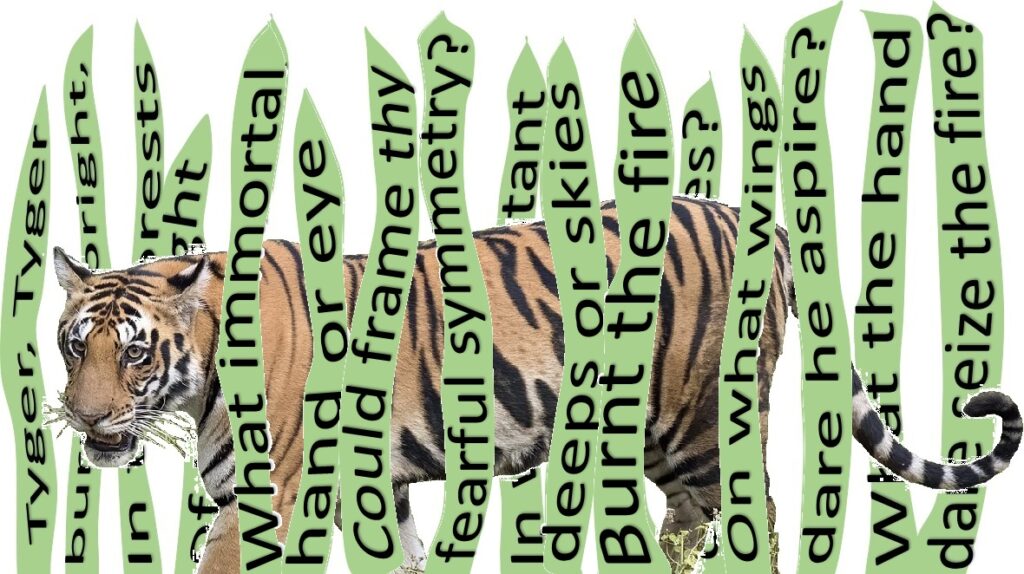Ah, the metaphor. The perfect asset for rendering the abstract concrete, for elevating prose above mere banal description, for igniting the fire of words.

I’ve written about metaphors before, but only to distinguish them from their showy, weaker fellow creatures, similes. The poor, attention-starved simile. It’s like a male peacock, brandishing ‘like’ or ‘as’ to signal the reader, to flash its tail feathers, saying, “Look at me! I’m making a comparison!”
A metaphor shows no signal, gives no sign. It’s unannounced, sneaky, and subtle. A trained tiger lurking within a jungle of words. Hidden power, and beauty.
I attended a webinar this week titled “The Magic of Metaphor,” by author Marin Sardy, and that inspired this post. She refreshed my knowledge of this trained predator, one I’ve too often left languishing in its cage. Thanks to her, I’ve fed the beast, stroked its fur, let it get some exercise, and vowed to present it more often.
All metaphors hinge on an absurdity. A thing is not a thing, says the metaphor, it is some other thing. It’s not like something else. It is something quite different. X is Y. Shakespeare asserts the whole world is a stage. They’re the same thing, equal.
Absurd. The whole world is not a stage. You know that. Shakespeare knew you’d know that. But your mind, that highly evolved pattern recognition engine, saw the link and made the connection. The world resembles a stage in some respects—got it.
Ms. Sardy discussed the various types of metaphor, the different tricks your trained tiger can perform. Simple, Compound, Extended, Implied, and Conceptual. You can look those up elsewhere. Each takes the basic ‘X is Y’ formulation and twists it a different way.
Metaphors help readers understand and appreciate your story. The ‘X’ is something in your story—hard to describe, difficult to picture, outside the reader’s experience. In the cited metaphor by Shakespeare, “all the world” is fuzzy, nebulous, too big to grasp. Your powerful trained tiger equates that with ‘Y,’ something known to readers, tangible, and easier to imagine. “A stage.”
If your tiger performs well, Ms. Sardy says, the metaphor is clear, apt, original, and authentic. On a bad day, the tiger bites its trainer-author in the form of a cliché, or metaphors that are mixed, stacked, or forced.
Ms. Sardy addressed how to train your tiger—that is, how to choose the right metaphor. Given the ‘X’ of your story, how do you select the perfect ‘Y?’ The four pieces of advice, put in my own words, follow:
- Push past the obvious. List a bunch of candidate ‘Ys’ (perhaps by mind-mapping) and don’t pick the first ones that occur to you.
- Think for yourself. Don’t copy, or even attempt to imitate, the metaphors of other writers.
- Understand the ‘X.’ Put yourself as deeply into your story as you can. Immerse your mind in it. Only by being there can you convey an appropriate and vivid comparison.
- Draw from past experience. Think about similar things from your own past. That may help you select the right ‘Y,’ one familiar to readers.
Note: In this post, I’ve transposed Ms. Sardy’s marvelous webinar into my own words. She didn’t use a trained tiger to describe metaphors—that’s my idea. I take the blame for any misinterpretation of her wonderful talk.
Ready to show off your trained tiger? At the literacy circus, a spotlight shines down on the center ring. A vast, reading audience waits in their seats, anxious to find out if your trained tiger act is better than that of—
Poseidon’s Scribe
